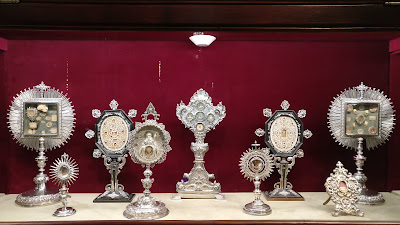Today we did a tourist-y thing and went to the Catedral de Sevilla. I'm not going to recount all of the superlatives associated with this edifice (see the wikipedia link). Suffice to say it's huge, it's old and it's impressive. Spain is a very catholic country. Within Spain, Sevilla is a very catholic city. The Catedral is part of the city's identity. Each neighborhood church is connected and represented by some part of this massive cathedral. Further, it's a living entity with daily masses and a regular congregation. The artifacts contained in the myriad side chapels, nooks and crannies are often taken out into the streets for processions associated with various catholic organizations within the city.
Here are few pictures I took. These are just some that I found interesting. You can find much better pictures on-line. First, most of the side chapels had some kind of tomb inside. The tombs usually contained the remains of important figures in church history. They were invariably ornately carved pieces of art:
The Catedral de Sevilla holds the remains of Christopher Columbus:
It also displays a variety of relics (a nice way of saying human body parts) of saints. This display literally had bits of bone, hair, and teeth of saints:
We climbed to the top of the Giralda, a tower that was originally an Islamic minaret, but when Spain was taken back from predominantly Islamic rule, the minaret was converted to a bell tower and the associate mosque knocked down and replaced with a catholic cathedral. The view of the Triana neighborhood from the top was fun. If you really blow this up, you can see our bridge (the best bridge):
There is an enclosed square in the Catedral that used to be a place of ablutions for muslims at the former mosque. It is now an orange grove with lovely fountains. Of particular interest to me is the fact that the fountains feed a network of irrigation channels in the pavement that water the trees in the grove:
This fountain had an orange leaf and a ripe orange floating in it. You also see the surrounding irrigation channels:
Obligatory selfie:
Included in the admission to the Catedral was admission to the nearby El Divino Salvador another catholic church. Though the structure itself only dates back to the 17th century, it has been the site of a mosque, church and/or roman temple since 200BC. Once again, you can find a lot of photos of this church on-line. Here are a few that stood out to me:
This massive "float" is carried around Sevilla during religious processions. It's all made of metal and must be massively heavy. As with so many of the artifacts we saw today, I can't get over the intricacy of them. Each figure, flourish and shape is/was the result of some conscious living artisan. Each detail was placed with purpose and thought. You get a sense of this when you zoom in on the above and see this:
This is a choir room. I like the massive music stand in the middle:
Here's an example of the giant hymnals that were presumably placed on these great stands:
This is one of my favorite statues of Jesus. He's kind of sitting on a stool, in the "thinker" pose, but clearly worn out after a three-day-long crucifixion:
Finally, it was beautifully sunny here in Sevilla. The sun coming through the stained glass was lovely:
That was our day of tourism.
***
In other news, I figured out how to record and plot my own GPS data on my own maps in python. Here's an example:
I'm looking forward to seeing what I can do with this new capability. It uses mapbox and plotly.













